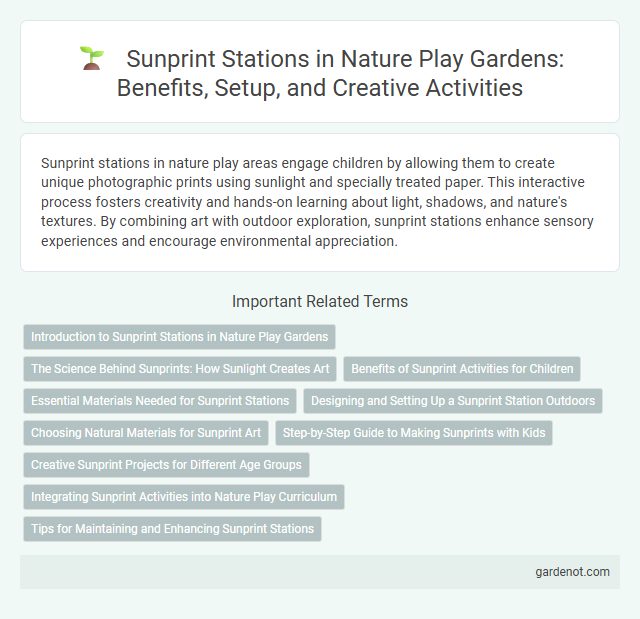Sunprint stations in nature play areas engage children by allowing them to create unique photographic prints using sunlight and specially treated paper. This interactive process fosters creativity and hands-on learning about light, shadows, and nature's textures. By combining art with outdoor exploration, sunprint stations enhance sensory experiences and encourage environmental appreciation.
Introduction to Sunprint Stations in Nature Play Gardens
Sunprint stations in nature play gardens use light-sensitive paper to create lasting images through exposure to sunlight, fostering hands-on learning about natural processes. Children place leaves, flowers, and other natural objects on the paper, which then changes color when exposed to sunlight, producing vivid silhouettes that capture the essence of the natural world. This interactive activity promotes exploration, creativity, and an early understanding of photochemical reactions in a playful outdoor setting.
The Science Behind Sunprints: How Sunlight Creates Art
Sunprint stations harness the ultraviolet (UV) radiation from sunlight to trigger a photochemical reaction on light-sensitive paper, causing exposed areas to bleach while covered sections remain dark. This process relies on the sun's UV rays breaking down ferric ammonium citrate and potassium ferricyanide compounds in the paper, creating crisp, permanent silhouettes of objects placed on its surface. The interplay between solar energy and chemical response illustrates fundamental principles of light absorption and molecular change in nature-based art activities.
Benefits of Sunprint Activities for Children
Sunprint activities at the Sunprint station enhance children's understanding of natural light and chemistry by allowing them to create images using sun-sensitive paper. These hands-on experiences boost creativity, fine motor skills, and scientific curiosity while promoting outdoor exploration and mindfulness in nature. Engaging with sunprints also supports cognitive development and fosters a meaningful connection with the environment.
Essential Materials Needed for Sunprint Stations
Essential materials needed for sunprint stations include sun-sensitive paper, a sturdy flat surface, and transparent objects such as leaves, flowers, or cut-out shapes to create prints. A clear acrylic sheet or glass panel helps press objects evenly onto the paper while blocking unwanted shadows. Access to direct sunlight or a UV light source is crucial for activating the sunprint process and achieving vivid blue and white images.
Designing and Setting Up a Sunprint Station Outdoors
Designing and setting up a sunprint station outdoors involves selecting a flat, well-lit area exposed to direct sunlight for optimal print development. Use UV-sensitive paper, a transparent acrylic sheet, and natural objects like leaves or flowers for creating unique sunprints. Incorporate a drying rack and protective shading to preserve the prints and ensure a smooth workflow in the outdoor environment.
Choosing Natural Materials for Sunprint Art
Selecting natural materials such as leaves, flowers, and feathers enhances the authenticity and creativity of Sunprint art. These organic elements create intricate, detailed impressions when exposed to sunlight, capturing the unique textures and shapes found in nature. Incorporating diverse natural materials encourages outdoor exploration and deepens the connection between participants and their natural environment.
Step-by-Step Guide to Making Sunprints with Kids
Kids can create vibrant sunprints by placing objects like leaves or shells on sunprint paper and exposing it to sunlight for 3 to 5 minutes. After exposure, rinse the paper gently with water to reveal striking blue and white silhouettes. This engaging activity encourages outdoor exploration and teaches children about the effects of sunlight on photosensitive materials.
Creative Sunprint Projects for Different Age Groups
Sunprint stations offer a hands-on experience where children and adults of all ages create vibrant cyanotype prints using natural materials like leaves and flowers. Younger children benefit from simple shapes and bold contrasts, while older participants can experiment with intricate patterns and layering techniques to enhance their artistic expression. This activity not only encourages creativity but also fosters an appreciation for nature's details through the unique sun-exposed images.
Integrating Sunprint Activities into Nature Play Curriculum
Integrating Sunprint activities into a nature play curriculum enhances sensory learning by encouraging children to explore light, shadows, and natural objects creatively. This hands-on approach promotes scientific inquiry and artistic expression, fostering environmental awareness and curiosity about the natural world. Incorporating Sunprint stations supports STEM education goals while nurturing imaginative play and observation skills in outdoor settings.
Tips for Maintaining and Enhancing Sunprint Stations
Regularly replace sun-sensitive paper to ensure vibrant, clear prints at the Sunprint station while storing unused sheets in a cool, dark place to preserve their light sensitivity. Clean the station's acrylic surface gently with a soft cloth and mild soap to prevent scratches that can affect image quality. Encourage users to experiment with various natural objects like leaves or flowers to create diverse and striking sunprints, enhancing both engagement and creativity.
Sunprint station Infographic

 gardenot.com
gardenot.com